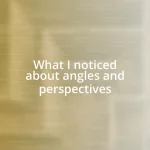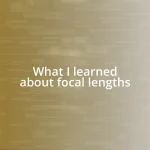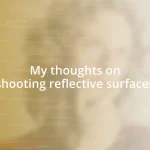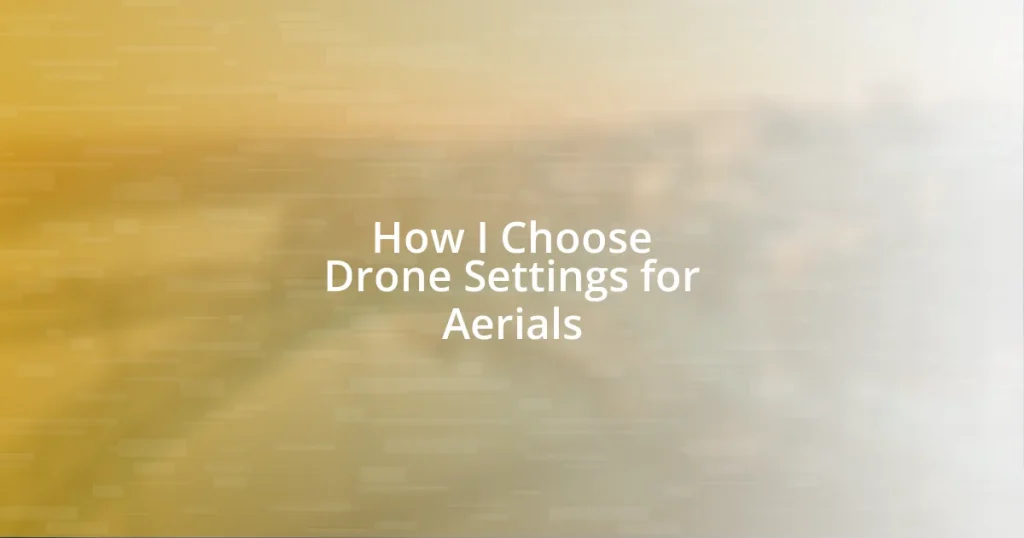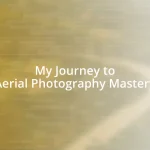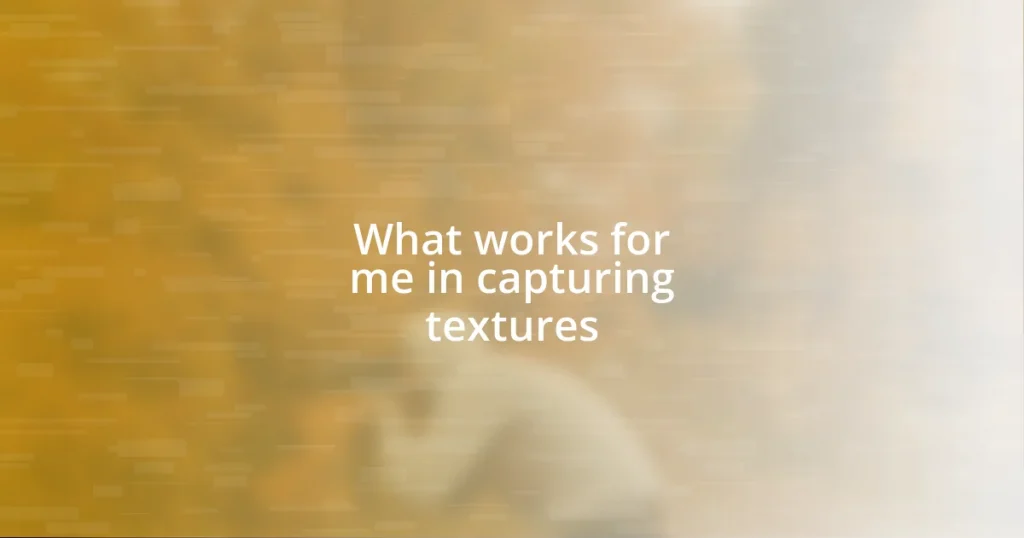Key takeaways:
- Understanding ISO, shutter speed, and exposure is crucial for enhancing aerial photography quality, impacting light sensitivity and motion capture.
- Key factors such as lighting conditions, subject matter, and altitude significantly influence drone settings and the resulting image quality.
- Post-flight evaluation of settings and maintaining a steady frame rate, along with planning for lighting and battery life, are essential for achieving consistent aerial results.

Understanding Drone Settings Basics
When you first start flying a drone, the technical settings can feel overwhelming. I remember my first flight; I was almost paralyzed by the multitude of options available. It made me think—how crucial is it really to understand these basics? The truth is, having a solid grasp of things like ISO, shutter speed, and white balance can dramatically improve your aerial photography.
ISO controls the sensor’s sensitivity to light. I once shot at a higher ISO during dusk, thinking it would brighten my images, but instead, I ended up with a grainy mess. Have you ever gone through photos only to find they don’t capture the beauty you saw? That’s often a result of misunderstanding how to manage these settings.
Shutter speed is another essential factor. It not only affects how motion is captured but also affects the overall exposure of the shot. When I started using slower shutter speeds to get those dreamy, blurred backgrounds, I learned the hard way about the need for stability. Why does it take falling flat on your face to really appreciate the importance of keeping your drone steady? Knowing how to manipulate these settings can transform your aerial shots from mundane to mesmerizing.

Factors Influencing Drone Settings
The factors influencing drone settings can significantly affect the quality of your aerial shots. One pivotal element is lighting conditions. I recall a shoot during golden hour; the soft light created stunning images, and I realized how important it was to adjust my settings accordingly. I often find myself tweaking the ISO and shutter speed to adapt to changing light, which makes a noticeable difference in the final result.
Another factor I consider is the subject matter. Different scenarios demand different approaches. For example, when capturing fast-moving subjects like a car rally, I’ve learned to increase the shutter speed to freeze action effectively. On the other hand, when photographing landscapes, I prefer a lower shutter speed to emphasize the grandeur of nature. Balancing these settings helps convey the story behind the image.
Finally, I never underestimate the impact of altitude. When flying higher, the light behaves differently, and I find it’s essential to re-evaluate my settings. Just a few meters up can alter the colors and exposure significantly. I’ve experienced this firsthand during a drone flight over a lake; adjusting my settings as I gained altitude was crucial for those breathtaking reflections, turning a simple shot into something extraordinary.
| Factor | Impact |
|---|---|
| Lighting Conditions | Dictates ISO and shutter speed adjustments for better exposure. |
| Subject Matter | Affects shutter speed selection based on motion. |
| Altitude | Changes how light interacts with the drone, requiring settings reevaluation. |

Adjusting Exposure for Aerial Photography
Adjusting exposure for aerial photography is an art form that can really elevate your shots. The first time I captured a breathtaking sunset over the mountains, I was so focused on the scenery that I neglected to tweak my exposure settings. The result was a stunning view, but my images ended up too dark to truly reflect the vibrant hues I had seen. It hit me just how essential adjusting exposure is—not just for clarity but for capturing the soul of the scene.
To fine-tune exposure, I always consider the following key aspects:
– ISO: A higher ISO can brighten images but might introduce noise. Lower ISOs help retain clarity but may require more light.
– Shutter Speed: This should be adjusted to match your subject’s motion. Slow for landscapes, fast for moving subjects.
– Aperture: A wider aperture allows more light in, reducing depth of field and blurring the background, emphasizing your subject.
One of my favorite drone moments happened when I misjudged the exposure settings while flying past a coastal cliff. The sun was setting, casting incredible colors, yet I could hardly see the details of the rock formations in the images. That taught me a valuable lesson about constantly monitoring and adjusting exposure to quickly adapt to shifting light. Now, I take a moment to scan each scene, visualizing how adjusting even one setting can transform the overall mood of my photographs.
- Histogram: I often check the histogram. It helps balance light and shadow, ensuring I don’t clip important details.
- Bracketing: I sometimes take multiple exposures of the same scene. This technique allows me to blend images later, capturing a full range of light.
- Neutral Density Filters: These filters have become my best friend. They allow me to shoot with wider apertures in bright light, letting me retain that artistic feel without overexposing my shots.

Choosing the Right Flight Mode
When it comes to choosing the right flight mode for my drone, I always consider the type of shots I want to capture. For instance, I favor the “Positioning” mode when I need stability and precision, especially for landscape shots where every detail counts. Have you ever tried flying in an area with strong winds? That mode became my best ally during such conditions because it keeps the drone steady, allowing for clear, sharp images amid the turbulence.
In contrast, I lean towards the “Sport” mode for fast-paced action, like during an outdoor event. The sheer thrill of maneuvering the drone swiftly to follow a moving subject really gets my adrenaline pumping! I remember a vibrant festival where I captured dancers as they swirled through the crowd. The ability to quickly pivot and adjust my path made those exhilarating moments possible, giving me footage that felt alive and dynamic.
Choosing the right flight mode ultimately hinges on your intention for the shoot. Do you want to capture something serene or chaotic? I often pause to ask myself this question before takeoff. Knowing my goals helps me select the appropriate mode, whether I’m looking for that cinematic sweep or a focused detail shot. Taking the time to consider these options only enhances the overall quality of my aerial photography, creating a solid grounding for all other settings I adjust.

Post-Flight Settings Adjustments
After landing, I take a moment to evaluate my flight settings. I often review my exposure adjustments based on the conditions I just encountered. For instance, during a recent shoot over a lake at sunset, I noticed that my images didn’t capture the warm glow I’d anticipated. This made me realize that small tweaks to the aperture and shutter speed can turn a good shot into a captivating one.
I’ve also learned the value of checking the white balance settings post-flight. I once flew during a morning fog, and the initial shots were washed out and lifeless. By adjusting the white balance to compensate for the haziness, I could revive those images, filling them with richness and contrast. This process of reevaluation isn’t just a technical necessity; it’s part of connecting with the essence of what I’ve captured.
Lastly, I always make it a habit to evaluate the specific flight modes I used. Did “Positioning” mode provide the stability I needed, or should I have switched to “Sport?” Reflecting on these choices helps me understand how each mode affects the final outcome. I often jot down notes after particularly productive flights. This practice keeps my learning curve steep and my future aerials even more dynamic.
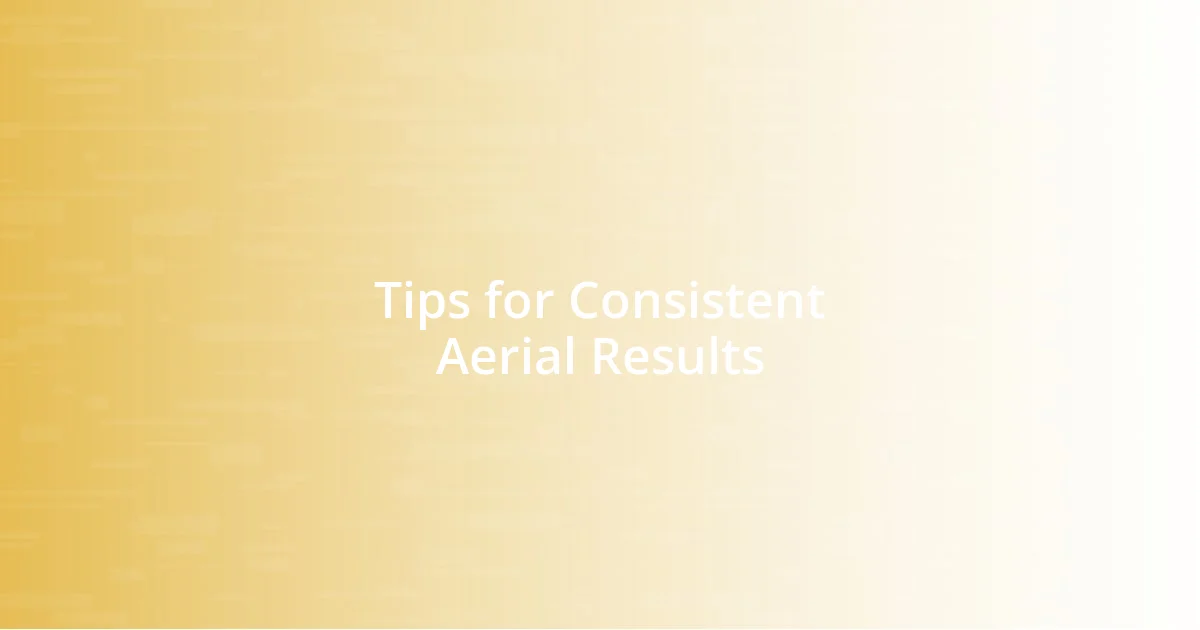
Tips for Consistent Aerial Results
When aiming for consistent results in aerial photography, I find it essential to maintain a steady frame rate. I typically set my drone to capture at the highest frame rate available, which allows for smoother footage, especially when I’m editing later. Have you ever tried to piece together a shot only to find it shaky or jittery? Trust me, it’s frustrating, and I’ve learned that prioritizing frame rates can drastically enhance the fluidity of your final product.
Another tip is to keep an eye on your drone’s battery life. I recall a time when I was so immersed in capturing the golden hour that I neglected to monitor my battery percentage. The drone unexpectedly landed mid-flight, which was a heart-stopping moment! Now, I always plan my shots with battery life in mind, ensuring I have enough power to complete my vision without interruptions. Setting a pre-flight checklist has been a game-changer for me; it ensures that I’m organized and ready to capture everything I’ve envisioned.
Lastly, I believe lighting plays a crucial role in achieving consistency. I often scout the location beforehand to determine how light interacts with the landscape at different times of day. I remember a shoot in a dense forest where the canopy created unexpected shadows. By planning my flight during the golden hour, I avoided those harsh contrasts and captured the warm, enchanting look I aimed for. So, how do you approach lighting in your shoots? By considering these factors, I cultivate a deeper connection to my environment, resulting in aerial images that resonate with both emotion and artistry.



